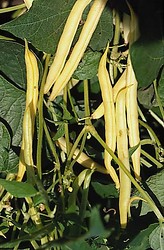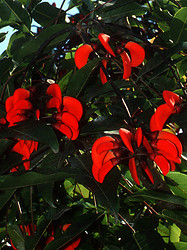Millettioid sensu lato clade
Martin F. Wojciechowski


This tree diagram shows the relationships between several groups of organisms.
The root of the current tree connects the organisms featured in this tree to their containing group and the rest of the Tree of Life. The basal branching point in the tree represents the ancestor of the other groups in the tree. This ancestor diversified over time into several descendent subgroups, which are represented as internal nodes and terminal taxa to the right.

You can click on the root to travel down the Tree of Life all the way to the root of all Life, and you can click on the names of descendent subgroups to travel up the Tree of Life all the way to individual species.
For more information on ToL tree formatting, please see Interpreting the Tree or Classification. To learn more about phylogenetic trees, please visit our Phylogenetic Biology pages.
close boxIntroduction
The Millettioid sens. lat. clade includes all genera in the tribes Millettieae (except for Afgekia, Callerya, and Wisteria in the IRLC), Abreae, Indigofereae, Phaseoleae, and Psoraleeae, and subtribes Desmodiinae and Lespedezinae of Desmodieae (Wojciechowski et al., 2004). The predominantly tropical, woody Old World tribe Millettieae has been considered to be a "transitional link" from the "less advanced" members of tribes Dalbergieae and Sophoreae to the putatively "more advanced" Old World tribes like Phaseoleae and Galegeae (Geesink, 1981, 1984; Polhill, 1981); the term "advanced" was used by these authors to indicate a high degree of fusion of stamens and keep petals, as well as the accumulation of non-protein amino acids in seeds rather than alkaloids.
Members of this clade are primarily distributed in tropical and subtropical to warm temperate regions of the Old World. Tribe Indigofereae, with seven genera and c. 768 species, is predominantly African-Madagascan in distribution; the large genus Indigofera (c. 700 spp.) is distributed pantropically (Schrire, 2005a. Tribe Abreae, with 17 species in the sole genus Abrus, is predominantly African-Madagascan in distribution, with a few species in Asia and two that are pantropical (Schrire, 2005c). Tribe Millettieae, with 45 genera such as Derris, Millettia, and Lonchocarpus, and c. 910 species (Schrire, 2005b), is primarily distributed in tropical to subtropical Africa and Australasia with a few groups found in the Neotropics (e.g., the Lonchocarpus, Piscidia, and Tephrosia groups).
Discussion of Phylogenetic Relationships
Early studies using rbcL sequences by Doyle et al. (1997) and subsequent studies using nuclear phytochrome gene sequences (Lavin et al., 1998), chloroplast matK/trnK sequences (Hu et al., 2000), and combined molecular data (Hu, 2000) conclusively showed that Millettieae and Phaseoleae are polyphyletic tribes, and that tribe Indigofereae formed the sister group to them. The emerging pattern of relationships in the Millettieae sens. lat. clade derived from these studies and more recent analyses of molecular sequence data (Kajita et al., 2001; Wojciechowski et al., 2004) is that most of the constituent genera of Millettieae and Phaseoleae are included in two very well-supported subclades, the first dominated by tribe Millettieae and including tribe Abreae and subtribes Diocleinae and Ophrestinae of Phaseoleae, forming the sister group to a second subclade comprised of tribe Phaseoleae (sens. strict.) together with tribes Desmodieae and Psoraleeae. Relationships within each of these subclades are still very uncertain, due in large part to the large number of genera in Millettieae (45 genera & c. 910 spp.; Schrire, 2005b) and Phaseoleae (89 genera & c. 1570 spp.; Schrire, 2005d), many of which have not been sampled for any analysis to date. However, it is clear that neither tribe Millettieae (Schrire, 2005b) nor Phaseoleae (Schrire, 2005d), as currently circumscribed, are monophyletic; i.e., Abreae and subtribes Diocleinae and Ophrestinae of Phaseoleae are nested within a paraphyletic Millettieae, and Desmodieae and Psoraleeae are nested within a paraphyletic Phaseoleae.
References
Doyle, J. J., J. L. Doyle, J. A. Ballenger, E. E. Dickson, T. Kajita, and H. Ohashi. 1997. A phylogeny of the chloroplast gene rbcL in the Leguminosae: taxonomic correlations and insights into the evolution of nodulation. American J. Botany 84: 541-554.
Geesink, R. 1981. Tephrosieae. Pages 245-260 in Advances in Legume Systematics, part 1 (R. M. Polhill and P. H. Raven, eds.). Royal Botanic Gardens, Kew, UK.
Geesink, R. 1984. Scala Millettiarum. Leiden Bot. Ser. 8: 1-131.
Hu, J.-M. 2000. Phylogenetic relationships of the tribe Millettieae and allies-the current status. Pages 299-310 in Advances in Legume Systematics, part 9 (P. S. Herendeen and A. Bruneau, eds.). Royal Botanic Gardens, Kew, UK.
Hu, J.-M., M. Lavin, M. F. Wojciechowski, and M. J. Sanderson. 2000. Phylogenetic systematics of the tribe Millettieae (Leguminosae) based on matK sequences, and implications for evolutionary patterns in Papilionoideae. American J. Botany 87: 418-430.
Kajita, T., H. Ohashi, Y. Tateishi, C. D. Bailey, and J. J. Doyle. 2001. rbcL and legume phylogeny, with particular reference to Phaseoleae, Millettieae, and allies. Systematic Botany 26: 515-536.
Lavin, M., E. Eshbaugh, J.-M. Hu, S. Matthews, and R. A. Sharrock. 1998. Monophyletic subgroups of the tribe Milletieae (Leguminosae) as revealed by phytochrome nucleotide sequence data. American J. Botany 85: 412-433.
Lewis, G., B. Schrire, B. MacKinder, and M. Lock (eds). 2005. Legumes of the world. The Royal Botanical Gardens, Kew, UK.
Polhill, R. M. 1981. Papilionoideae. Pages 191-208 in Advances in Legume Systematics, part 1 (R. M. Polhill and P. Raven, eds.). Royal Botanic Gardens, Kew, UK.
Schrire, B. D. 2005a. Indigofereae. Pages 361-365 in Legumes of the world (Lewis et al., eds.). Royal Botanic Gardens, Kew, UK.
Schrire, B. D. 2005b. Millettieae. Pages 367-387 in Legumes of the world (Lewis et al., eds.). Royal Botanic Gardens, Kew, UK.
Schrire, B. D. 2005c. Abreae. Pages 389-391 in Legumes of the world (Lewis et al., eds.). Royal Botanic Gardens, Kew, UK.
Schrire, B. D. 2005d. Phaseoleae. Pages 393-431 in Legumes of the world (Lewis et al., eds.). Royal Botanic Gardens, Kew, UK.
Wojciechowski, M. F., M. Lavin, and M. J. Sanderson. 2004. A phylogeny of legumes (Leguminosae) based on analysis of the plastid matK gene resolves many well-supported subclades within the family. American J. Botany 91: 1846-1862.
Title Illustrations

| Scientific Name | Phaseolus vulgaris L. |
|---|---|
| Specimen Condition | Live Specimen |
| Copyright | © Robert Kiedrowski |
| Scientific Name | Erythrina falcata Bentham |
|---|---|
| Location | Peru |
| Comments | Member of tribe Phaseoleae |
| Specimen Condition | Live Specimen |
| Copyright | © Robin Foster |
About This Page
Martin F. Wojciechowski

Arizona State University, Tempe, Arizona, USA
Correspondence regarding this page should be directed to Martin F. Wojciechowski at
Page copyright © 2006 Martin F. Wojciechowski
All Rights Reserved.
- First online 14 June 2006
- Content changed 14 June 2006
Citing this page:
Wojciechowski, Martin F. 2006. Millettioid sensu lato clade. Version 14 June 2006 (under construction). http://tolweb.org/Millettioid_sensu_lato_clade/60341/2006.06.14 in The Tree of Life Web Project, http://tolweb.org/









 Go to quick links
Go to quick search
Go to navigation for this section of the ToL site
Go to detailed links for the ToL site
Go to quick links
Go to quick search
Go to navigation for this section of the ToL site
Go to detailed links for the ToL site